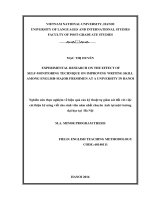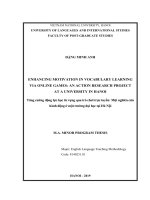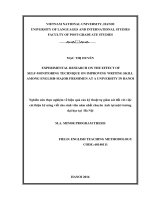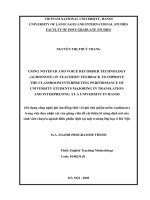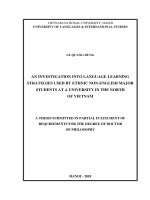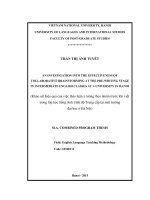Experimental research on the effect of self monitoring technique on improving writing skill among english major freshmen at a university in hanoi
Bạn đang xem bản rút gọn của tài liệu. Xem và tải ngay bản đầy đủ của tài liệu tại đây (514.79 KB, 62 trang )
VIETNAM NATIONAL UNIVERSITY, HANOI
UNIVERSITY OF LANGUAGES AND INTERNATIONAL STUDIES
FACULTY OF POST-GRADUATE STUDIES
----------
MẠC THỊ HUYỀN
EXPERIMENTAL RESEARCH ON THE EFFECT OF
SELF-MONITORING TECHNIQUE ON IMPROVING WRITING SKILL
AMONG ENGLISH-MAJOR FRESHMEN AT A UNIVERSITY IN HANOI
Nghiên cứu thực nghiệm về hiệu quả của kỹ thuật tự giám sát đối với việc
cải thiện kỹ năng viết cho sinh viên năm nhất chuyên Anh tại một trường
đại học tại Hà Nội
M.A. MINOR PROGRAM THESIS
FIELD: ENGLISH TEACHING METHODOLOGY
CODE: 60140111
HANOI 2016
VIETNAM NATIONAL UNIVERSITY, HANOI
UNIVERSITY OF LANGUAGES AND INTERNATIONAL STUDIES
FACULTY OF POST-GRADUATE STUDIES
----------
MẠC THỊ HUYỀN
EXPERIMENTAL RESEARCH ON THE EFFECT OF
SELF-MONITORING TECHNIQUE ON IMPROVING WRITING SKILL
AMONG ENGLISH-MAJOR FRESHMEN AT A UNIVERSITY IN HANOI
Nghiên cứu thực nghiệm về hiệu quả của kỹ thuật tự giám sát đối với việc
cải thiện kỹ năng viết cho sinh viên năm nhất chuyên Anh tại một trường
đại học tại Hà Nội
M.A MINOR PROGRAM THESIS
FIELD: ENGLISH TEACHING METHODOLOGY
CODE: 60140111
SUPERVISOR: Dr. TRẦN THỊ THU HIỀN
HANOI 2016
DECLARATION
I hereby state that I, Mac Thi Huyen, being a candidate for the degree of Master
of Arts (TEFL) accept the requirements of the university relating to the retention
and use of Master Thesis deposited in the library.
In terms of these conditions, I agree that the origin of my paper deposited in the
library should be accessible for the purposes of study and research, in
accordance with the normal conditions established by the librarian for the care,
loan or reproduction of the paper.
Signature
i
ACKNOWLEDGEMENTS
It is my pleasure to thank those who made this thesis possible.
Firstly, I owe my deepest gratitude to my supervisor, Dr. Tran Thi Thu Hien,
whose encouragement, guidance and support from the initial to the final level
enabled me to develop an understanding of the subject.
Secondly, I would like to thank Ms. Pham Thu Duong and Ms. Le Thi Thu
Thuy, two teachers of English at the research site (English Department, a Hanoibased university) for their invaluable assistance together with professional
advice during the research time.
Thirdly, this thesis would not have been possible without the enthusiastic
participation of 58 English-major freshmen at English Department of the
university where the research was carried out.
Lastly, I offer my regards and blessings to all of those who supported me in any
respect during the completion of the study.
Mac Thi Huyen
ii
TABLE OF CONTENTS
DECLARATION ....................................................................................................... i
ACKNOWLEDGEMENTS ..................................................................................... ii
ABSTRACT ...............................................................................................................v
LIST OF CHARTS AND TABLE ......................................................................... vi
PART I: INTRODUCTION .....................................................................................1
1. Rationale ................................................................................................................1
2. Aims and objectives...............................................................................................2
3. Scope of the study ..................................................................................................2
4. Research questions ................................................................................................3
5. Method of the study ..............................................................................................3
PART II: DEVELOPMENT ....................................................................................5
CHAPTER 1: LITERATURE REVIEW ................................................................5
1. 1. Writing ...............................................................................................................5
1.1. 1. Definition of writing ....................................................................................5
1.1.2. The roles of writing in a second language ..................................................6
1.1.3. Approaches to the teaching of writing in ESL classes ...............................7
1.1.4. The reasons that make writing difficult to master ....................................12
1. 2. Self-monitoring ................................................................................................14
1.2.1. Definition of self-monitoring .....................................................................14
1.2.2. Self-monitoring technique: annotation .....................................................15
1.2.3. Drawbacks of self-monitoring technique .................................................16
1.3. Review of the previous studies ........................................................................17
CHAPTER 2: METHODOLOGY .........................................................................20
2.1. Rationale for using experimental method ......................................................20
2.2. Setting of the study ...........................................................................................21
2.2.1. The university .............................................................................................21
2.2.2. The participants ..........................................................................................21
2.2.3. The intervention .........................................................................................22
iii
2.3.1. The pretest and posttest ..............................................................................24
2.3.2. The four writing tasks ................................................................................25
2.3.3. The semi-structured interview ...................................................................26
2.4. Data collection procedures ..............................................................................26
2.5. Data analysis methods......................................................................................27
CHAPTER 3: RESULTS AND DISCUSSION ....................................................29
3.1. Evaluation of the annotations made by the experimental group students in
the four writing tasks ..............................................................................................29
3.2. Comparison of the experimental and control groups’ writing performance
...................................................................................................................................32
3.2.1. Comparison of the experimental and control groups’ writing
performance in the pretest ...................................................................................32
3.2.2. Comparison of the experimental and control groups’ writing
performance in the posttest ..................................................................................33
3.3. The semi-structured interview ........................................................................35
PART III: CONCLUSIONS...................................................................................42
1. Major findings .....................................................................................................42
2. Pedagogical implications ....................................................................................44
3. Limitations of the study ......................................................................................45
4. Suggestions for further studies ..........................................................................45
REFERENCES .......................................................................................................... I
APPENDICES ........................................................................................................ IV
APPENDIX 1: THE SEMI-STRUCTURED INTERVIEW QUESTIONS ...... IV
APPENDIX 2: THE PRETEST ............................................................................. V
APPENDIX 3: THE POSTTEST .......................................................................... VI
APPENDIX 4: SOME TYPICAL SAMPLES OF STUDENTS’S
ANNOTATIONS MADE IN THE FOUR WRITING TASKS.........................VII
APPENDIX 5: A SAMPLE ANNOTATED TEXT .......................................... VIII
iv
ABSTRACT
This experimental research was conducted at a university in Hanoi within 5
months. The participants consisted of 58 English-major freshmen. The research
aims at investigating the efficiency of self-monitoring technique to student
writing performance and explore the students‟ attitudes toward this technique.
Self-monitoring in writing was understood as a new learning method in which
students annotate their texts with any doubts they have during the writing
process and the teacher can give feedback not only on the finished draft but also
reply to the students‟ questions. Pretest, posttest, four writing tasks and semistructured interview are all instruments employed by the researcher. The
findings reveal that the students can be trained to use self-monitoring
effectively. The annotations they made in their compositions grew both in
quantity and quality in terms of content, organization and language form. Selfmonitoring was successful in improving student writing proficiency. Their
writing scores significantly increased from pretest to posttest. The majority of
the students took a positive attitude toward self-monitoring. They believed in the
efficacy of self-monitoring in spite of some difficulties at the beginning and
recommended the continuation of self-monitoring for the next school year with
more training time as well as more self-monitoring models. Pedagogical
implications and suggestions for future studies are drawn out based on the
research findings.
v
LIST OF CHARTS AND TABLE
Page
Chart 1.1: Producing a Piece of Writing (Raimes, 1983: 6) ............................... 7
Chart 1.2: Stages of Writing in “The Process Approach” ................................ 11
Chart 3.1: Annotations made by the students during the four writing tasks ..... 29
Table 3.2: Descriptive statistics for the pretest score of the two groups ........... 31
Table 3.3: Independent samples t-test of the pretest score between the two groups
............................................................................................................................ 31
Table 3.4: Descriptive statistics for the posttest score of the two groups ......... 32
Table 3.5: Independent samples t-test of the posttest score between the two groups
............................................................................................................................ 33
vi
PART I: INTRODUCTION
This part is dedicated to introducing the rationale of the study, the problem to be
addressed in the study, the aims and objectives of the study, and the research
questions to be answered. It will also present the scope of the study, an overview
of the employed methods and the design of the study.
1. Rationale
Writing is considered a complicated and multifaceted task. Good writing
involves thinking that may lead the writer to express himself/herself in a more
effective way. For learners of English, writing is a vital skill, one of the main
criteria to measure a learner‟s second language proficiency. Unfortunately,
writing is a difficult skill which is not easy to be improved. Therefore, various
approaches to teaching writing have been recommended to help cope with this
problem. Of all, self-monitoring is a technique the effectiveness of which is a
controversial issue among many researchers. As a matter of fact, there exists
some research on self-monitoring in teaching. However, little attention has been
paid to self-monitoring in writing teaching. In Vietnam, self-monitoring remains
a totally new concept which has not been researched in academic papers.
Hopefully, this thesis will help shed light on the effect of self-monitoring in
writing class in the specific context of a university in Vietnam.
The context chosen by the researcher to conduct this research is English
Department of a Hanoi-based university. The participants all are first-year
majors. Of the four language skills taught here, writing is regarded as not only
challenging but also boring by the mainstream first-year major students. The
students encounter numerous difficulties when being asked to produce in-class
texts. It is actually hard for them to produce a high quality text due to such
reasons as language incompetence, lack of motivation and a traditionally passive
way of learning. They tend to ignore writing and pay more attention to the three
other language skills. As a result, the students have fewer opportunities of
success at academic writing when they move to higher levels in the later years
1
despite adequate oral communication skills. This long term consequence is
serious and worth being taken into consideration. How to teach the first year
English-major students to write well is a question posed in the many past years
drawing a lot of attention from the teachers.
With the desire for enhancing the quality of writings produced by major
freshmen as well as developing learners‟ autonomy, the researcher decides to
carry out the thesis “Experimental Research on the Effect of Self-Monitoring
Technique on Improving Writing Skill among English-Major Freshmen at a
University in Hanoi” by applying the self-monitoring technique in practice in
two writing classes. This study is hoped to be successful and bring about
feasible applications towards upgrading the learning and teaching writing for
English-major freshmen at this university as well as at other universities.
2. Aims and objectives
The research aims at investigating the effect of self-monitoring technique on
improving writing skill among English-major freshmen at a university in Hanoi.
This fundamental aim can be achieved when the two following objectives are
met. The first objective of the study is to find out the effects of self-monitoring
technique on the students‟ writing improvement. Next, the researcher wishes to
explore the students‟ attitudes towards self-monitoring technique.
3. Scope of the study
The scope of the research has been made quite clear from the title:
“Experimental research on the effect of self-monitoring technique on improving
writing skill among English-major freshmen at a university in Hanoi.”
Firstly, the research focuses on “self-monitoring technique in writing.” To be
more specific, it refers to the process in which students write notes or
annotations on their writings before handing it to the teacher. This will help
students place themselves in the position of readers, not only writers. As for
teachers, self-monitoring technique gives them an opportunity to offer feedback
2
not only on the finished draft but also on the queries which emerge during the
writing process.
Secondly, it is noteworthy that the subjects of the study are restricted to firstyear students at Faculty of English of a university in Hanoi. Therefore, all the
generalizations just serve to apply to the direct context.
4. Research questions
This research focuses on answering the following questions:
1. What are the effects of self-monitoring technique on English-major
freshmen‟s writing performance?
2. What are these students‟ attitudes towards self-monitoring technique?
5. Method of the study
As can be seen from the title, this research is an experimental one which is
participated by 58 English-major freshmen equivalent to an experimental group
and a control group at a university in Hanoi, Vietnam and implemented within
five months. The findings are reported based on the students‟ scores on pre-test,
post-test, the number of annotations obtained from four writing tasks in
combination with the students‟ responses in the semi-structured interview.
Besides these main instruments, classroom observation is made use of to get
further information. In the last place, constant discussions with the supervisor
and colleagues are of great significance.
6. Design of the study
The study is divided into three main parts:
Part I (Introduction) includes the rationale, the aims and objectives, the
scope, the research questions, the method and the design of the study.
Part II (Development) consists of chapters as follows
-Chapter 1 (Literature review) presents the theoretical background of the
study and the review of the previous studies.
- Chapter 2 (Methodology) describes in detail the research methodology
which consists of the context of the study, the information of the subjects,
3
instruments of data collection, procedures of data collection and methods
of data analysis.
- Chapter 3 (Results and Discussion) reports the statistical results and the
analysis of the data.
Part III (Conclusion) closes the study by summarizing the whole study
with concluding remarks and offering some limitations and suggestions
for further studies.
4
PART II: DEVELOPMENT
CHAPTER 1: LITERATURE REVIEW
This chapter has an overview of the literature on the filed of writing and selfmonitoring. It consists of definition of writing, the roles of writing in a second
language, approaches to teaching writing in ESL classes, the reasons that make
writing difficult to master, definition of self–monitoring and self-monitoring
technique: annotation. Review of the previous studies self-monitoring and
drawbacks of self-monitoring technique have also been presented with both
studies on the efficacy of self-monitoring and drawbacks of self-monitoring
technique.
1. 1. Writing
1.1. 1. Definition of writing
Writing is a significant and essential in the development in a native language
and in a second language; therefore, there have been numerous definitions of
writing. According to Byrne (1991:1) writing can be regarded as the “act of
forming graphic symbols” or the “making marks on the flat surface of some
kinds” while Brannon, Knight and Neverow-Turk (1982:2) pointed out that
“writing is a creative art, not as an assembly line operation of locking words
together into sentences and bolting sentences together into paragraphs in
accordance with a predefined plan.” Byrne does not seem to share the same
view with Brannon, Knight, Neverow-Turk in stating that “writing is a sequence
of sentences arranged in a particular order and link together in a certain way.”
Rozakis (1997:4) also defined that “writing is a way of communicating a
message to a reader for a purpose.” Her emphasis is on the communicative
function of writing as what Leki (1976:4) wrote “writing is a communication.
Good writing gets your ideas out of your head and into the reader’s head
without losing or distorting these ideas.” From another view of writing, Murray
(1978:29) and Perl (1979:43) defined writing as “a creative discovery procedure
5
characterized by the dynamic interplay of content and language: the use of
language to explore beyond the known content.”
However, writing, in language teacher‟s opinions, is “a language skill which is
difficult to acquire” (Tribble, 1996: 3). It is “a process that occurs over a period
of time, particularly if we take into account the sometimes extended periods of
thinking that precede creating an initial draft” (Harris, 1993:10)
1.1.2. The roles of writing in a second language
To master a language, obviously it is impossible for learners not to learn writing
skill well. As a basic productive skill, writing provides students with a chance to
put all the language elements they have learnt into practice. Emphasizing the
significance of writing, White (1991:1) wrote: “Through writing we are able to
share ideas, arouse feelings, persuade and convince other people. We are able
to discover and articulate ideas in ways that only writing makes possible.”
According to Raimes (1983: 3), writing is very important since it helps students
learn in some ways:
First, writing reinforces the grammatical structures, idioms, and vocabulary that we
have been teaching our students. Second, when our students write, they also have a
chance to be adventurous with the language, to go beyond what they have just learned
to say, to take risks. Third, when they write, they necessarily become very involved
with the language; the effort to express ideas and the constant use of eye, hand and
brain is a unique way to reinforce learning. As writers struggle with what to put down
next or how to put it down on paper, they often discover something new to write or a
new way of expressing their idea. They discover a real need for finding the right word
and the right sentence. The close relationship between writing and thinking makes
writing a valuable part of any language course.
6
1.1.3. Approaches to the teaching of writing in ESL classes
In order to produce a good piece of writing, learners have to deal with a lot of
elements. The following diagram demonstrates these elements clearly:
SYNTAX
CONTENT
Sentence structure,
relevance, clarity,
Sentence boundaries,
originality,
Stylistic choices, etc.
logic, etc.
THE WRITING’S
GRAMMAR
PROCESS
Rules for verbs,
getting ideas
Agreement, articles,
getting started
Pronouns, etc.
writing drafts
MECHANICS
Clear, fluent
and effective
communication
of ideas
Handwriting,
Revising
AUDIENCE
the reader(s)
Spelling,
Punctuation, etc
ORGANIZATION
WORD CHOICE
Paragraphs,
vocabulary
Topic and support,
idiom, tone
PURPOSE
the reason for writing
Cohesion and unity
Chart 1.1: Producing a Piece of Writing (Raimes, 1983:6)
Raimes (1983:5) states that on the basis of stressing different features of this
diagram and combing them with how teachers think writing is learnt, a variety
7
of approaches to the teaching of writing have been developed. Accordingly,
Raimes classifies approaches to the teaching of writing into six types, namely:
(i) The Controlled-to-Free Approach, (ii)The Free-Writing Approach, (iii) The
Paragraph-Pattern Approach, (iv) The Grammar-Syntax-Organization Approach,
(v) The Communicative Approach and (vi) The Process Approach.
1.1.3.1.The Controlled-to-Free Approach
In the 1950s and early 1960s, the most popular approach used in ESL classes
was the audio-lingual. The controlled-to-free approach was a product of the
audio-lingual period with its emphasis on step-by-step learning and formal
correctness. This approach stresses three features of the diagram above:
grammar, syntax and mechanics. It emphasizes accuracy rather than originality.
In this approach, students are taught how to write by variously doing sentence,
paragraph and manipulation exercises such as changing questions to statements,
present to past, changing words or clauses or combing sentences. With these
controlled compositions, it is relatively easy for students to write a great deal
with limited opportunity to make mistakes so the teacher‟s job of marking paper
is quick and easy. Gradually, the amount of control is reduced. And when
students reach an advanced level of proficiency, they are allowed to try some
free compositions, in which they can express their own ideas.
Byrne (1991) regards the controlled-to-free approach as “accuracy-oriented
approach” that “produces many useful ideas on how to guide writing” although
it is no longer fashionable.
1.1.3.2. The Free-Writing Approach
In contrast with the controlled-to-free approach, the free-writing approach
encourages students to write as much as possible and as quickly as possible
without worrying about making errors. Teachers in this approach have stressed
quantity of writing rather than quality by assigning vast amounts of free writing
on given topics with only minimal correction of errors. The important thing is
that students can write down all their ideas on paper. Grammatical accuracy,
8
organization and the rest will gradually follow. In this way, students feel that
they are actually writing, not merely doing exercises of some kind so they can
write what they want to write and as a result they find writing an enjoyable
experience. Thus in this approach, concern for “audience” and “content” in the
diagram are taken into consideration. Byrne (1991:22) also supports the freewriting approach, a fluency-approach, for the cause that “many students write
badly because they do not write enough and for the same reason they feel
inhibited when they pick up a pen. Most of us write less well if we are obliged to
write about something. A fluency-approach, perhaps channeled into something
like keeping a diary, can be a useful antidote.”
1.1.3.3. The Paragraph-Pattern Approach
Different from two approaches above, the paragraph-pattern one highlights the
importance of organization, another feature of the diagram. This approach is
mainly concerned to teach students how to construct and organize paragraphs.
Students simply copy paragraphs, analyze the form of model paragraphs and
imitate model passages. Their concrete tasks are putting scrammed sentences
into paragraph order, identifying general and specific statements, choosing or
inventing an appropriate topic sentences and inserting or deleting sentences.
This approach has its own advantages pointed out by Byrne (1991:23) “this
approach identifies and tries to overcome one of the central problems in
writing: getting students to express themselves effectively at a level beyond the
sentence.”
1.1.3.4. The Grammar-Syntax-Organization Approach
From the viewpoint that writing cannot be seen as composed of separate skills
which are learned one by one, this approach stresses the necessity to work
simultaneously on more than one of the features in the composition diagram:
grammar, syntax and organization. Teachers give students writing tasks that lead
them to pay attention to organization while they also work on the necessary
grammar and syntax. For instance, to write a clear set of instructions on how to
9
operate a washing machine, students need more than the appropriate vocabulary.
They need the simple forms of verbs; an organizational plan based on
chronology; sequence words like first, then, finally; and even sentence structures
like “when…; then…”. This approach can link the purpose of a piece of writing
to the forms that are needed to convey meaning.
1.1.3.5. The Communicative Approach
In reality, we normally have a reason for writing and we write to somebody.
These factors have often been ignored in teaching and practicing writing. Yet,
the communicative approach can resolve this situation by providing students
with the purpose and the audience for their piece of writing. Student writers are
encouraged to behave like writers in real life and to ask themselves the crucial
questions about purpose and audience:
Why am I writing this?
Who will read it?
In the communicative approach, it is easy for teachers to devise situations which
allow students to write purposefully. For example, students can write to one
another in the classroom or use writing in role-play situations. Also, teachers can
specify readers outside the classroom, thus giving students writers a context in
which to select appropriate content, language and levels of formality.
“Although, like the free-writing, this approach does not resolve specific
problems which students have when handling the written language, it does
motivate them to write and shows how writing is a form of communication.”
(Byrne, 1991:23)
1.1.3.6. The Process Approach
In recent years, the concentration of teaching writing has not put on the written
product but on the process of writing. Student writers should ask themselves not
only questions about purpose and audience but also the crucial questions:
How do I write this?
How do I get started?
10
This approach lays particular stress on a cycle of writing activities which move
students from the generation of ideas and the collections of data through to the
„publication‟ of a finished text. The diagram below shows the whole process not
as a fixed sequence but a dynamic and unpredictable process:
PREWRITING.
(specifying the task/planning and outlining/collecting data/make notes)
COMPOSING/DRAFTING
REVISING
EDITING
(checking grammar/lexis/surface features)
PUBLISHING
Chart 1.2: Stages of writing in “The Process Approach”
In this process approach, teachers in ESL classes give their students the
opportunity to explore a topic fully in such prewriting activities as discussion,
reading, debate, brainstorming and list making. Students do not necessarily
produce the first piece of writing in a restricted time and hand in the
composition for the teacher to correct or grade. Rather, they explore a topic
through writing, showing the teacher and each other their drafts and using what
they write to read over, think about, and move them on to new ideas. After
getting the appropriate feedback from readers, the teacher and other students,
they will discover new ideas, new sentences and new words, then revise and edit
what they have written in the first draft to prepare for the publication of the
second one.
However, student writers do not often follow a neat sequence of planning,
organizing, writing and then revising. At any point in the preparation of a text,
they can loop backwards or forwards to whichever of the activities involved in
text composition they may find useful. For instance, they may need to revise the
11
plan radically in order to cope with changes that have developed in the
argument, or may want to revise the style of earlier sections before going on to
write later parts of the text as they come to appreciate how best to reach their
intended audience. Teachers who use this approach give their students two
crucial supports: time for students to try out ideas and feedback on the content of
what students write in their drafts. They consider writing process as a process of
discovery for their students: discovery of new ideas and new language forms to
express those ideas.
It can be concluded that although all the above-mentioned approaches address
the various features that a students needs to consider in producing a piece of
writing, they still have something in common. No approach to teaching writing
is seen as the most optimal and unique for every teaching context. A teacher
using a communicative or a process approach can still use the techniques drawn
from other approaches as the students need them; model paragraphs, controlled
compositions, free writing, sentence exercises and paragraph analysis are useful
in all approaches. Therefore, it is important for teachers to appropriately choose
approaches for different circumstances and make the best use of the advantages
of those approaches to help students make great progress in their writing
learning.
1.1.4. The reasons that make writing difficult to master
According to Byrne (1991:4), there are three problems causing writing to
become a difficult activity for most people, both in the mother tongue and in a
foreign language. They are psychological problems, linguistic problems and
cognitive problems.
1.1.4.1. Psychological problems
It‟s a common knowledge that speech is the natural and normal medium of
communication for us in most circumstances and accustoms us both to having
someone physically present when we use language and to getting feedback of
some kind. Writing, on the other hand, is essential a solitary activity and the fact
12
that we are required to write on our own, without the responsibility of
interaction or the benefit of feedback, in itself makes the act of writing difficult.
1.1.4.2. Linguistic problems
Oral communication is sustained through a process of interaction and except in
special circumstances, such as a lecture, the participants help to keep it going.
Because speech is normally spontaneous, we have little time to pay attention
either to organizing our sentence structures or to connecting our sentences: to
some extent, the latter is maintained through the process of interaction. We
repeat, backtrack, expand and so on, depending on how people react to what we
say. Incomplete and even grammatical utterances usually pass unnoticed.
In writing, we have to keep the channel of communication open through our
own efforts and to ensure, both through our choice of sentence structure and by
the way our sentences are linked together and sequenced, that the text we
produce can be interpreted on its own.
1.1.4.3. Cognitive problems
We grow up learning to speak and in normal circumstances spend much of our
time doing it. We also appear to speak without much conscious effort or thought
and generally we talk because we want to, about matters which are of interest or
relevant to us socially or professionally.
Writing, on the other hand, is learnt through a process of instruction; we have to
master the written form of the language and to learn certain structures which are
less used in speech, or perhaps not used at all, but which are important for
effective communication in writing. We also have to learn how to organize our
ideas in such a way that they can be understood by a reader who is not present
and perhaps by a reader who is not known to us. Furthermore, writing is a task
which is often imposed on us, perhaps by circumstances. This is not only has a
psychological effect; it may also cause a problem in terms of content-what to
say. Being at a loss for ideas is a familiar experience to most of us when we are
obliged to write.
13
1. 2. Self-monitoring
1.2.1. Definition of self-monitoring
Self-monitoring is a component of self-regulation which also consists of selfinstruction, self-evaluation, self-correction, self-reinforcement (Mace, Belfiore,
& Hutchison,
2001), self-observation,
self-judgment and self-reaction
(Zimmerman, 1989). The line separating these processes is often unclear
(Benson, 2001) because as Schunk (2001) observes they are interrelated and
dependent. Of all the terms, however, self-monitoring is most widely used and
best describes the process discussed in this study.
O‟Malley and Chamot (1990) define self-monitoring as “checking one’s
comprehension during listening or reading or checking one’s accuracy and/or
appropriateness of one’s oral or written production while it is taking place” and
contrast this with self-evaluation, which is “checking the outcomes of one’s own
language learning against a standard after the learning has been completed”.
(p.232)
Wenden (1991) offers a similar definition that differentiate self-monitoring and
self-evaluation based on the time lapsed between production and assessment.
This time period, however, does not change the nature of the evaluation process.
Evaluation occurs both during and after learning.
Self-monitoring is used as a procedure for changing behavior due to its
reactivity, or its ability to alter a behavior simply through self-observation and
self-recording. Because of this reactivity, self-monitoring has been called “the
lifeblood of effective self-control methods” (Thorensen & Mahoney, 1974). The
subject seemingly becomes more aware of the target behavior and thus its
frequency changes (Nelson & Hayes, 1981). Reactivity is desirable because it
almost always creates change in a desired or positive direction (Cooper at al.,
1987:24). The more obtrusive an observation and measurement method, the
greater the likelihood of reactivity (Kazdin, 1974). Because the subject in
14
behavior change effort is also the recorder and observer, obtrusiveness is at its
fullness and there is a good chance for reactivity (Cooper et al., 1987)
Self-monitoring working as a writing technique was first recommended by
Charles (1990). He proposed a self-monitoring technique, whereby students
annotate their texts with any doubts they have during the writing process so that
the teacher can give feedback not only on the finished draft but also on the
queries which emerge during the writing process. In other words, in this
technique, students annotate their drafts with comments or queries on their
problems before handling their texts in to the teacher. The teacher responds in
writing to these notes, thus giving direct and appropriate feedback on the points
raised by the students.
The writer of this study wish to carry out a study on the effect of self-monitoring
technique on the students‟ writing improvements. Therefore, the term “selfmonitoring” in this study strictly follows Charles‟s viewpoint.
1.2.2. Self-monitoring technique: annotation
Annotating a text, or making the pages with notes, is an excellent way to acquire
the most out of the reading. The students often do this for college courses
because annotations allow the students to locate information at a fast rate when
they need to review a text. Annotations offer the students an opportunity to
familiarize themselves with both the content and organization of what they read.
A new way of engaging ideas and issues directly through comments, questions,
associations, or other actions that occur when reading is provided. Thanks to
annotating, learning process turns an active one and annotating becomes an
integral step in the writing process.
A well-annotated text should accomplish all of the following:
Clearly identify where in the text important ideas and information are
located
Express the main ideas of a text
Trace the development of ideas/arguments throughout a text
15
Introduce a few of the reader‟s thoughts and reaction
Before making major annotations, the students are advised to read the text
thoroughly once. Unfamiliar vocabulary or concepts should be circled. This way
will help them determine where the main ideas or important information are
located, and then make their annotations more efficient.
In common, annotating a text may be accomplished by four following ways:
Highlighting/Underlining
Paraphrasing/Summary of Main Ideas
Descriptive Outline
Comments/Responses
A sample annotated text which will serve as a useful source of reference for
further information can be found at appendix 5.
1.2.3. Drawbacks of self-monitoring technique
Research on revision indicates that writing is likely to be effective when
reviewing is concentrated on more „substantive‟ or „global‟ aspects of content
and organization, such as checking logicality, relevance of single ideas to the
global argumentation pattern, and appropriateness of content to the given reader
(Flower and Hayes 1981: 379, Faigley and Witte 1981: 409, Zamel 1983: 180).
This raises the issue that self-monitoring student writers‟ focus on language
problems might be at the expense of crucial attention to global concerns. Indeed,
Cresswell (2000) experienced that self-monitoring students‟ annotations focused
mainly on grammar rules or spelling. This led him to the conclusion that if selfmonitoring was to work properly, students needed to be made more conscious of
the importance of attention to global factors during reviewing. In other words, in
order for this technique to go a long way, training students how to use it
skillfully is indispensable.
A further issue is whether self-monitoring learners can adequately describe their
concerns. The example annotations presented by Charles (1990: 289) do in fact
show certain articulacy, but Creswell‟s personal experience was that self-
16
monitored annotations often failed to be specific in mentioning the writer‟s
composing intentions at the text-point in question. This convinced him of the
need for teacher-supervised practice in formulating annotations that expressed
writers‟ intentions.
In brief, in this chapter, both theoretical basis related to writing and selfmonitoring and review of the previous studies have been mentioned in detail.
These theories will serve as the foundation for the researcher to conduct and
develop the study according to specific methodology that will be elaborated in
the next chapter.
1.3. Review of the previous studies
There exits a wide range of research affirming the positive aspects of selfmonitoring in education.
Kormos (1999) concludes that the self-monitoring of second language speech
aids acquisition and is a positive correlate of proficiency.
Self-monitoring is a key instructional involvement of a self-regulatory approach
to writing. Using self-monitoring technique, a writer produces a personal
feedback loop. While writing down changes in specific aspects of writing,
writers are required to evaluate and react to their writing at a metacognitive
level. (Zimmerman and Risemberg, 1997)
Hyland (2000), Muncie (2000), Leki (1990) stated that the traditional way in
which teachers make comments on students‟ drafts is not effective in improving
students‟ writing.
Self-monitoring is effective for a variety of target behaviours, it is motivating, it
is portable, it develops independence, it aids in classroom management, and it is
learner centered. Self-monitoring is widely accepted as being an effective
procedure for behavior change. Self-monitoring has historically been viewed as
an important and valuable variable and, more recently, as a critical component
of child development and learning (Zimmerman & Schunk, 1989). It allows the
students to become aware of and responsible for their behavior.
17

